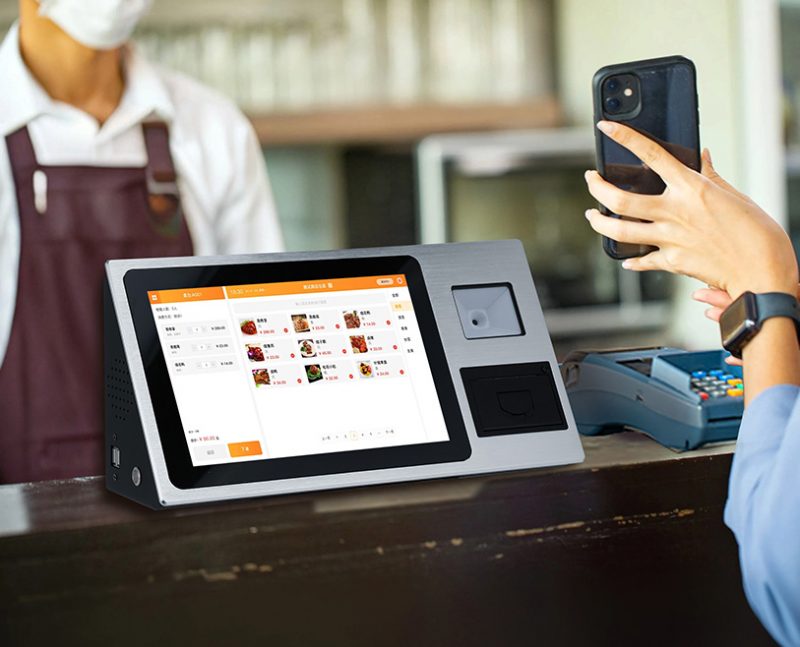In hoëdruk-industriële omgewings - waar split-sekonde besluite en vinnige taakuitvoering sukses definieer - het hoë-respons industriële raakskerms onontbeerlike hulpmiddels geword. Anders as standaard raakskerms wat by swaar gebruik sloer of wankel, hierdie gespesialiseerde uitstallings lewer byna onmiddellike reaksietye, laat operateurs komplekse koppelvlakke navigeer, parameters aanpas, en voer opdragte in millisekondes uit. Of dit nou op 'n bedrywige produksielyn is, 'n vinnige logistieke spilpunt, of 'n kritieke energiebeheerkamer, Industriële aanraakskerm met hoë reaksie skakel vertragings uit, verminder foute, en hou bedrywighede teen piekspoed beweeg.
Hierdie artikel duik in hul sleutelkenmerke, werklike toepassings, en unieke voordele, om industriële leiers te help om die regte oplossing te kies om vinnige werkvloeie te versterk.

Kernkenmerke van industriële aanraakskerms met hoë reaksie
1. Ultra-lae vertraging vir direkte interaksie
Die kenmerkende eienskap van hoë-respons industriële raakskerms is hul minimale aanraakvertraging - tipies 1–5 millisekondes (me), in vergelyking met 10–20 ms vir standaard industriële raakskerms. Hierdie byna onmiddellike reaksie beteken operateurs se krane, swipe, en gebare vertaal na onmiddellike aksies: verstel van 'n vervoerbandspoed mid-operasie, wissel tussen intydse data-kontroleskerms, of noodstops veroorsaak - alles sonder die frustrerende vertraging wat vinnige take kan ontwrig. Hierdie latensie word bereik deur gevorderde aanraaksensortegnologie (bv., geprojekteerde kapasitiewe of infrarooi) en geoptimaliseerde firmware wat insetverwerking prioritiseer.
2. Robuuste duursaamheid vir harde industriële instellings
Vinnige industriële omgewings is onvergewensgesind—stof, vibrasie, uiterste temperature, en toevallige impakte is algemeen. Hoë-respons industriële raakskerms is gebou om hierdie uitdagings te weerstaan:
Industriële graad materiale: Gehard glasoppervlakke weerstaan skrape, chemikalieë, en impak van gereedskap of puin.
Omgewingsveerkragtigheid: Gegradeer vir bedryfstemperature wat wissel van -20°C tot 60°C (-4°F tot 140 °F) en IP65+ beskerming teen stof en waterspatsels.
Vibrasie weerstand: Ontwerp om meganiese vibrasies van masjinerie te verduur, verseker konsekwente werkverrigting op produksielyne of mobiele industriële voertuie.
3. Hoë-definisie duidelikheid vir vinnige data-interpretasie
Vinnige take vereis dat operateurs inligting in 'n oogopslag verwerk - en industriële aanraakskerms met 'n hoë reaksie lewer met 'n hoë resolusie (1080p+) skerms en hoë helderheid (500+ nete) vertoon. Skerp beeldmateriaal, skerp teks, en lewendige kleurkontras maak dit maklik om intydse statistieke te lees, komplekse diagramme, of waarskuwingskennisgewings—selfs in helder fabrieksbeligting of lae sigbaarheid omgewings. Sommige modelle het ook anti-glans-bedekkings om refleksies uit te skakel, leesbaarheid verder verbeter tydens vinnige bedrywighede.
Sleuteltoepassings van industriële aanraakskerms met hoë reaksie
1. Vervaardiging & Produksielyne
In motormontering, elektroniese vervaardiging, of verpakkingsfasiliteite, Industriële aanraak met hoë reaksie Vertoon vinnig krag, herhalende take:
Vinnige parameter aanpassings: Operateurs pas masjienspoed aan, druk instellings, of produksie tel met 'n kraan, tred te hou met hoëvolume-uitset.
Intydse kwaliteitskontroles: Onmiddellike toegang tot inspeksiedata en defekwaarskuwings stel spanne in staat om probleme onmiddellik aan te spreek, duur stilstand te vermy.
Lynwisselings: Vinnige navigasie tussen produkspesifieke koppelvlakke verminder die oorskakelingstyd met 20–30%, algehele deurset te verhoog.
2. Logistiek & Pakhuise
Logistieke spilpunte en pakhuise maak staat op spoed vir bestellingvervulling en voorraadbestuur - en hierdie uitstallings lewer:
Vinnige strepieskode skandering integrasie: Raak-insette aktiveer onmiddellike strepieskode-herkenning, optel versnel, verpakking, en versendingsprosesse.
Intydse voorraadopdaterings: Operateurs werk voorraadvlakke op of spoor verskepings met 'n swiep op, akkuraat te verseker, bygewerkte data vir vinnige besluitneming.
Vurkhyser en AGV kontroles: Gemonteer op mobiele industriële voertuie, die skerms se lae vertraging laat bestuurders toe om klein spasies te navigeer en opdragte veilig teen spoed uit te voer.
3. Energie & Nutsbeheerkamers
In kragsentrales, olieraffinaderye, of waterbehandelingsfasiliteite, vinnige reaksie op skommelinge of noodgevalle is van kritieke belang:
Vinnige stelsel aanpassings: Operateurs wysig kraguitset, druk kleppe, of vloeitempo's onmiddellik om stabiliteit te handhaaf.
Noodreaksie: Een-aanraking toegang tot afskakelprotokolle of waarskuwingstelsels verminder die impak van onverwagte probleme.
Data dashboard navigasie: Naatlose wisseling tussen energieverbruik-metrieke, toerusting status, en veiligheidswaarskuwings hou operateurs ingelig en rats.
Voordele van hoë-respons industriële raakskerms vir vinnige take
1. Verhoogde produktiwiteit & Deurset
Deur aanraakvertraging uit te skakel en vinnige werkvloeie te vereenvoudig, hierdie skerms verminder taakvoltooitye met 15–40%. Byvoorbeeld, 'n verpakking lyn met behulp van hoë-respons industriële raakskerms kan verwerk 20% meer eenhede per uur as een met standaardskerms, aangesien operateurs minder tyd spandeer om te wag vir insette om te registreer en meer tyd op kerntake gefokus word.
2. Verminder menslike foute
Sloerige raakskerms lei dikwels tot toevallige invoere of herhaalde tik – duur foute in vinnige industriële instellings. Met byna onmiddellike reaksie, Industriële aanraakskerms met hoë reaksie verminder hierdie foute: operateurs se aksies word presies uitgevoer soos bedoel, afval te verminder, herwerk, en veiligheidsrisiko's.
3. Verbeterde operateurstevredenheid & Retensie
Frustrasie van nie-reageerbare tegnologie kan operateursmoraal dreineer - veral tydens hoëdrukverskuiwings. Hoë-respons industriële raakskerms laat vinnige take hanteerbaar voel, die vermindering van moegheid en die verbetering van werkstevredenheid. Hierdie, op sy beurt, verlaag personeelomset en verminder die tyd en koste om nuwe spanlede op te lei.
Gereelde vrae oor hoë-respons industriële raakskerms
V1: Wat is die tipiese reaksietyd van hierdie skerms?
A1: Die meeste industriële aanraakskerms met hoë reaksie bied 'n aanraakvertraging van 1–5 ms—vinnig genoeg vir selfs die vinnigste industriële take. Sommige premiummodelle behaal 'n vertraging van minder as 1 ms vir ultrakritiese toepassings soos noodkontroles.
V2: Kan hulle met handskoene of in nat toestande gebruik word?
A2: Ja - baie modelle ondersteun handskoenwerking (via verbeterde kapasitiewe of infrarooi aanraaktegnologie) en is IP65+ gegradeer om waterspatsels of klam omgewings te weerstaan, maak hulle ideaal vir voedselverwerking, buitelug industriële terreine, of skoonkamers.
V3: Is hulle versoenbaar met bestaande industriële sagteware en PLC's?
A3: Absoluut. Hierdie skerms ondersteun algemene industriële protokolle (bv., Modbus TCP, Ethernet/IP, PROFINET) en integreer naatloos met toonaangewende PLC-handelsmerke (Siemens, Rockwell, Delta) en industriële sagteware (SCADA, MES stelsels). Ons span kan versoenbaarheid met jou spesifieke opstelling verifieer.
V4: Hoe lank hou hoë-respons industriële raakskerms 24/7 bedrywighede?
A4: Met robuuste konstruksie en industriële-graad komponente, hulle hou gewoonlik 7–10 jaar in deurlopende gebruik. Die meeste kom met 'n 3–5 jaar waarborg wat defekte dek, verseker langtermyn betroubaarheid vir vinnige werkvloeie.
Gevolgtrekking
Hoë-reaksie industriële raakskerms is 'n speletjie-wisselaar vir industriële bedrywighede wat spoed vereis, presisie, en duursaamheid. Deur vertraging uit te skakel, duidelikheid te verbeter, en strawwe toestande weerstaan, hulle bemagtig operateurs om vinnige take met selfvertroue aan te pak, verhoog produktiwiteit, en verminder foute. Of u nou 'n produksielyn wil optimaliseer, vaartbelyn logistiek, of verbeter beheerkamerdoeltreffendheid, hierdie uitstallings lewer tasbare resultate wat 'n impak het op jou winspunt.
Gereed om te sien hoe hoë-respons industriële raakskerms jou vinnige bedrywighede kan transformeer? Vul die vorm op ons webwerf in om met ons industriële vertoonkundiges te praat. Ons sal jou spesifieke behoeftes assesseer, verskaf 'n pasgemaakte oplossing aanbeveling, en deel 'n gedetailleerde kwotasie—wat jou help om die eerste stap na vinniger te neem, meer doeltreffende werkstrome.

